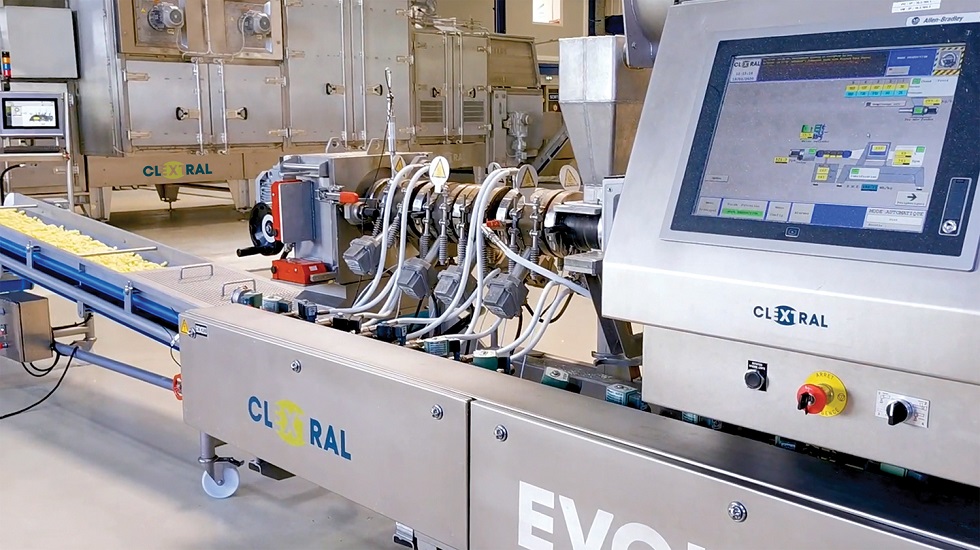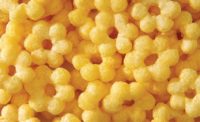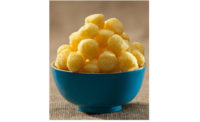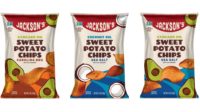As Snack Food & Wholesale Bakery Senior Editor Liz Parker reported in this year’s State of the Industry report on puffed and extruded snacks, sales in the category are on an upward trajectory. SF&WB recently connected with John Barber, sales manager with Clextral USA, to explore consumer trends, production and formulation challenges, and solutions available to producers looking to take advantage of opportunities in the field.
Jenni Spinner: Could you please talk about some of the most notable consumer trends in puffed/extruded snacks in recent years—what are consumers hungry for in that category, and what types of products are producers delivering?
John Barber: The trend of better-for-you snacks is continuing, with high protein dominating, along with new plant-based and pulse ingredients, with functional nutrition benefits ranging from heart health to mental health including CBD and hemp protein. In this area, we are working with non-traditional and more exotic ingredients including sorghum, quinoa, blue corn and sacha inchi. Exotic ingredients and flavors help differentiate a snack, especially if there is a story behind the ingredients, (history, health claims, sustainability, etc.)
Customers are also looking for vegetable or fruit ingredients in snacks, and snacks with clean labels and limited ingredients. On the other hand, indulgent snacks are still very popular, often with their own unique claims such as nutritional claims.
JS: Then, let's dig a little deeper—can you please talk about some of the production and formulation challenges unique to snacks in the category?
JB: Some ingredients, such as pulses, are heat sensitive, so it is important to factor this into the processing parameters. High protein grains can pose a challenge when we are working on expansion. This is where our work with processors during R&D is so important. In our test facilities, we utilize a range of ingredients regularly, and snack makers can benefit from our experience in their product development. Once we understand their goals for their snacks, we help to fine-tune the recipes and production parameters.
In addition, Clextral extruders have a proprietary Advanced Thermal Control (ATC), a self-learning device that continuously monitors and adapts to changes in operating conditions such as water, raw materials, humidity, operating actions, etc. in production parameters for optimized process control. This extruder intelligence allows Cltexto offer real intelligence to the extrusion machines, which gives the possibility to accurately control the temperatures in each barrel module with self-learning adjustment, improved response time, enhanced process stability (up to 70%), and energy savings (up to 20%).
 JS: What should producers of such snacks look for in processing equipment and other technology to ensure success?
JS: What should producers of such snacks look for in processing equipment and other technology to ensure success?
JB: Top priorities for most processors are flexibility and hygienic design, to allow them to transition from one snack type to another quickly with minimum downtime for sanitation. Regarding flexibility, our Evolum+ extrusion lines are built for maximum ingredient flexibility with a wide range of throughput rates. These extruders process many different types of raw materials which require specific thermo-cooking levels of energy while ensuring consistent product quality (texture, density, mouthfeel, etc.).
Regarding hygienic design, Clextral extruders have ergonomic profiles that allow complete access for sanitation, hygienically welded joints, open corners, and a patented auto-open barrel system that allow immediate screw access for reconfiguration and cleaning. Just browsing the internet on food safety and hygienic design, you can find numerous stories about food safety concerns. This has been a major focus for years at Clextral, when we develop equipment and technical solutions, in order to meet the food market demand. Food safety is essential for any food production and involves control at all the stages of the value chain. Clextral is a member of the EHEDG: European Hygienic Engineering & Design Groupe. European countries have some of the strictest guidelines and regulations in the world on food safety.
Automation is also key. Snack processors are facing challenging times and automation can help them reach required capacity while ensuring product quality. Automation enables processors to reduce labor requirements and avoid human errors, optimize their process and operation, ensure consistent product quality, obtain complete process data tracking, and communicate remotely for troubleshooting and process optimization.
Clextral’s Fitsys V3 digital controls manage tasks from recipe/batch preparation through line processing to the finished product after drying and seasoning, including automatic startup and shutdown for all extrusion processes. The digital controls and automation provide instantaneous monitoring on process and running conditions, operational performance, and product traceability from raw material receipt to the finished product.
Finally, processors should make sure that qualified automation resource support is available either from their supplier or outside services. Remote troubleshooting and process optimization are provided by Clextral.
JS: Can you talk about some of the solutions your company offers to help producers working in the category?
JB: When we are working on a snack, our challenge is always to make a product that appeals to consumers’ preferred texture, expansion, volume and density, in short, the qualities that make snacks fun to eat! We help snack makers differentiate their products whether new products or line extensions, with quality shapes, interesting appearances, and new flavor profiles.
In our test facilities, we have twin screw extruders and multiple upstream and downstream equipment options to help in developing their new concepts.
As the extruder is a highly versatile processing tool, it can process a range of products simply by changing process settings or parameters: dry ingredients, liquid ingredients, thermomechanical cooking through heat and shear, die configuration, and cutting device. These parameter changes can make snacks with textures from crisp/dense to melt-in-your-mouth light. We can manage different ingredients to achieve the attributes desired by modifying the recipes and extruder configurations.
As extrusion companies invest in innovations in dies, kit systems, profiles, and parameters, we help reduce the R&D cost for the processor, and make it faster, more efficient, and less risky to develop a new product. An example of this is die innovation for our new pea snack shapes. Our R&D in parameter and recipe adjustments for texture modification is another example, and our clip-on kits that give processors flexibility to easily make different products using the same extrusion line.
JS: Do you have anything to add?
JB: Clextral’s latest snack extrusion lines offer capacity of 5,000 lbs/hr, yet occupy similar floor space of a traditional line for 3,000 lbs/hr. Our latest EV+ dryer and coating systems allow snack manufacturers to easily switch from savory coating to sweet coating, giving them the flexibility to expand their product offerings using the same line. Finally, our extrusion clip-ons allow manufacturers to quickly set up the line to make new product shapes, filled products, with die face cut or post-extrusion cutting.





